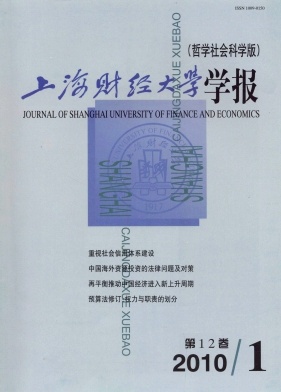金融危机与我国低碳贸易的发展
上海财经大学学报 2010 年 第 12 卷第 01 期, 页码:84 - 91
摘要
参考文献
摘要
2006年中国超过美国成为最大的二氧化碳排放国。来自国际社会的减排压力越来越大。金融危机背景下贸易保护主义抬头,限制碳排放正在成为发达国家新的"绿色壁垒",成为"中国威胁论"的新内容。本文采用投入产出和结构分解分析的方法,测算了2008年1月-2009年5月我国出口碳排放的变化。结果表明:金融危机有节能减排效用,规模效应促使中国出口碳排放显著降低,结构效应对出口碳也有改善作用。敏感性分析也表明金融危机有利于我国出口商品结构向低碳转型。文章针对我国出口贸易向低碳经济转型提出了一些对策建议。
[1]Ahmad,N.,Wyckoff,A.Carbon Dioxide Emissions Embodied in International Trade of Goods[D].OECD STI Working Paper,2003,(15).
[2]Antweiler,W.,Copeland,B.R.,Taylor,M.S.Is Free Trade Good for the Environment?[J].Ameri-can Economic Review,2001,(91):877-908.
[3]Bin Shui,Robert C.Harriss.The role of CO2embodi ment in US-China trade[J].Energy Policy,2006,(34):4063-4069.
[4]Chichilnisky G.North-south trade and the global environment[J].The American Economic Review,1994,(4),851-874.
[5]Copeland B.R.,Taylor M.S.North-Southtrade and the environment[J].The Quarterly Journal of Eco-nomics,1994,(8):755-787.
[6]Copeland B.R.,Taylor M.S.Trade and Transboundary Pollution[J].American Economic Review,1995,(4):716-737.
[7]Frankel J,Rose A.Is Trade Good or Bad for the Environment?Sorting out the Causality[J].The Review of Economics and Statistics,2002,(1):85-91.
[8]Nakano,S.,Okamura,A.,Sakurai,N.,Suzuki,M,.Tojo,Y,.Yamano,N.The measurement of CO2embodi ments ininternational trade:Evidence fromthe harmonised Input-Output and bilateral trade data-base,OECD STI Working Paper,2009,(3).
[9]Peters,G.P.,Hertwich,E.G.CO2embodied in international trade with i mplications for global cli mate policy[J].Environmental Science and Technology,2008,(42):1401-1407.
[10]Schaeffer.The embodi ment of carbon associated with Brazilian i mports and exports[J].Energy Conver-sion and Management,1996,(37):955-960.
[11]Tonooka,Y.,Mu,H.,Ning,Y.,Kondo,Y.Energy consumption in residential house and emissionsinventory of GHGs,air pollutants in China.Journal of Asian Architecture and Building Engineering,2003,(1):1-8.
[12]Wang,T.,Watson,J.Who Owns China’s Carbon Emissions?Tyndall Centre for Cli mate Change Re-search,Sussex,UK.2007.
[13]Weber,C.L.,Peters,G.P.,Guan D.,Hubacek,K.The contribution of Chinese exports to cli mate change[J].Energy Policy,2008,(9):3572-3577.
[14]Wyckoff,A.W.,Roop,J.M.The embodi ment of carbonini mports of manufactured products[J].En-ergy Policy,1994,(22):187-194.
[15]You Li,C.N.Hewitt.The effect of trade between China and the UKon national and global carbon diox-ide emissions.Energy Policy,2008,(36):1907-1914.
[16]陈迎,潘家华,谢来辉.中国外贸进出口商品的内涵能源及其政策含义[J].经济研究,2008,(7):11-25
[17]刘强,庄幸,姜克隽,韩文科.中国出口贸易中的载能量及碳排放量分析[J].中国工业经济,2008,(8):46-55.
[18]齐晔,李惠民,徐明.中国进出口贸易中的隐含碳估算[J].中国人口、资源与环境,2008,(18):8-12.
[19]孙小羽,臧新.中国出口贸易的能耗效应和环境效应的实证分析[J].数量经济技术经济研究,2009,(4):33-44.
[20]姚枝仲.中国贸易结构的变动:2001—2008[J].国际经济评论,2008,(6):28-30.
[21]闫云凤,杨来科.中美贸易与气候变化———基于投入产出法的分析[J].世界经济研究,2009,(7):40-44
[22]闫云凤,杨来科.全球金融危机与我国的出口贸易:冲击与对策[J].东南亚纵横,2009,(7):72-75
[2]Antweiler,W.,Copeland,B.R.,Taylor,M.S.Is Free Trade Good for the Environment?[J].Ameri-can Economic Review,2001,(91):877-908.
[3]Bin Shui,Robert C.Harriss.The role of CO2embodi ment in US-China trade[J].Energy Policy,2006,(34):4063-4069.
[4]Chichilnisky G.North-south trade and the global environment[J].The American Economic Review,1994,(4),851-874.
[5]Copeland B.R.,Taylor M.S.North-Southtrade and the environment[J].The Quarterly Journal of Eco-nomics,1994,(8):755-787.
[6]Copeland B.R.,Taylor M.S.Trade and Transboundary Pollution[J].American Economic Review,1995,(4):716-737.
[7]Frankel J,Rose A.Is Trade Good or Bad for the Environment?Sorting out the Causality[J].The Review of Economics and Statistics,2002,(1):85-91.
[8]Nakano,S.,Okamura,A.,Sakurai,N.,Suzuki,M,.Tojo,Y,.Yamano,N.The measurement of CO2embodi ments ininternational trade:Evidence fromthe harmonised Input-Output and bilateral trade data-base,OECD STI Working Paper,2009,(3).
[9]Peters,G.P.,Hertwich,E.G.CO2embodied in international trade with i mplications for global cli mate policy[J].Environmental Science and Technology,2008,(42):1401-1407.
[10]Schaeffer.The embodi ment of carbon associated with Brazilian i mports and exports[J].Energy Conver-sion and Management,1996,(37):955-960.
[11]Tonooka,Y.,Mu,H.,Ning,Y.,Kondo,Y.Energy consumption in residential house and emissionsinventory of GHGs,air pollutants in China.Journal of Asian Architecture and Building Engineering,2003,(1):1-8.
[12]Wang,T.,Watson,J.Who Owns China’s Carbon Emissions?Tyndall Centre for Cli mate Change Re-search,Sussex,UK.2007.
[13]Weber,C.L.,Peters,G.P.,Guan D.,Hubacek,K.The contribution of Chinese exports to cli mate change[J].Energy Policy,2008,(9):3572-3577.
[14]Wyckoff,A.W.,Roop,J.M.The embodi ment of carbonini mports of manufactured products[J].En-ergy Policy,1994,(22):187-194.
[15]You Li,C.N.Hewitt.The effect of trade between China and the UKon national and global carbon diox-ide emissions.Energy Policy,2008,(36):1907-1914.
[16]陈迎,潘家华,谢来辉.中国外贸进出口商品的内涵能源及其政策含义[J].经济研究,2008,(7):11-25
[17]刘强,庄幸,姜克隽,韩文科.中国出口贸易中的载能量及碳排放量分析[J].中国工业经济,2008,(8):46-55.
[18]齐晔,李惠民,徐明.中国进出口贸易中的隐含碳估算[J].中国人口、资源与环境,2008,(18):8-12.
[19]孙小羽,臧新.中国出口贸易的能耗效应和环境效应的实证分析[J].数量经济技术经济研究,2009,(4):33-44.
[20]姚枝仲.中国贸易结构的变动:2001—2008[J].国际经济评论,2008,(6):28-30.
[21]闫云凤,杨来科.中美贸易与气候变化———基于投入产出法的分析[J].世界经济研究,2009,(7):40-44
[22]闫云凤,杨来科.全球金融危机与我国的出口贸易:冲击与对策[J].东南亚纵横,2009,(7):72-75
引用本文
闫云凤, 杨来科. 金融危机与我国低碳贸易的发展[J]. 上海财经大学学报, 2010, 12(1): 84–91.
导出参考文献,格式为:





 7186
7186  456
456

